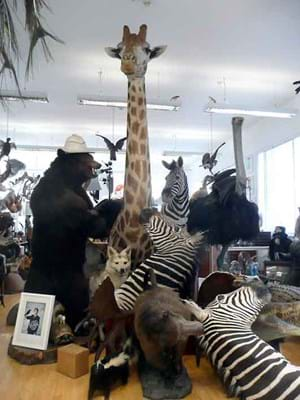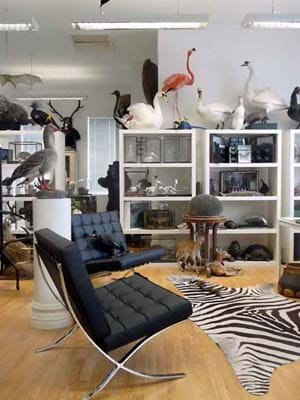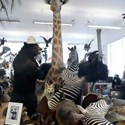Not a line you might hear every day, but for Alexis this is pretty mundane stuff. Over the past 20 years he has dealt in natural history and taxidermy, while also building a busy prop hire company for film, TV and photo shoots which now dominates his business, London Taxidermy.
His light, airy showroom is an utterly bizarre place to be - a sort of exotic macabre menagerie in suburban Southfields in south west London, of all places. A giraffe greets you as you walk in the door, surrounded by some zebra heads (their 'stylish' graphic stripes make these particularly popular with interior decorators) and to one side a stack of Curver boxes containing various cats and dogs sit waiting to go to Tatler.
I accidentally tread on an alligator's claw and instinctively bend down to give it an apologetic pat.
Having moved the zebra foal out of the way so we can see each other, Alexis (a Jack Russell curled up at his feet - also stuffed) tells me about how he got into this strange niche - a far cry from his early career as a DJ and TV presenter in the 1980s when he was in his 20s. Having decided that hosting a live pop show for teenagers was not for him, he set up a recruitment company in Mayfair with his now wife. This grew quickly but three years later the recession of the early 1990s killed the business overnight.
It was then, with nothing to lose, that Alexis turned to dealing. From an early age, taxidermy had intrigued him - as a child he attended auctions with his father and would often bid on bits of taxidermy, most of which he says were "horrid".
Young Demand
Taxidermy has risen enormously in popularity over the past decade, particularly in the last five years, and a lot of young people are particularly interested in the area - many of Alexis' clients are in their twenties and thirties, including a lot of art students who buy and hire pieces for installations and photoshoots.
Alexis credits taxidermy's increasing acceptability in part to its widespread use by fashion designers, such as the late Alexander McQueen and milliner Philip Treacy, and a new wave of taxidermy artists, notably Polly Morgan and Kate MccGwire - are all regular clients. And alongside hiring pieces, Jonathan Ross often buys birthday and Christmas presents for his wife from Alexis.
Taxidermy seems to have largely shrugged off its unsavoury, not to mention unethical, image of moth-eaten trophy kills gathering dust in country houses and proof of its current appeal was underlined by the enormous prices fetched at Christie's South Kensington's sale of the stock from Will Fisher's Jamb last year when a stuffed bulldog made £15,500 and two Victorian cased chihuahuas fetched £12,000 and £16,000 each.
Although this sale was an anomaly - Alexis had an influx of people approaching him with taxidermy dogs after the auction, expecting five-figure sums - it still reflects the broader revival of the market.
"Ten years ago similar taxidermy would never have made anywhere near that much money, and it was interesting that some of the pieces in that sale made more than some of the furniture and works of art," he said.
Cased Birds
It was in 1992 at Rosebery's auctioneers in South London that Alexis made his first purchase that set him on this particular dealing path: a large Victorian case of birds for £20 which, looking back, he says was "rubbish". But he split it up, mounted each bird individually and sold them onto a dealer at a decent profit. He was hooked.
Discovering ATG was also instrumental: "I saw a dealer reading a copy in his car, and realised that's how everyone knew where all these auctions were!"
Although at first he bought anything he could afford - mainly from "country house attic sales, with the emphasis on attic" - it was seeing an advert in ATG in 1996 for a David Lay sale in Penzance, mentioning a "natural history collection", that was the fateful moment.
It was, in fact, the taxidermy collection from St Michael's Mount. Alexis booked a phone line for the whole day and bought over 100 of the 180 lots, kick-starting his taxidermy career, as he sold on much of the collection quickly, introducing him to key contacts in the market that he still deals with today.
Then in 2005 came his lucky break, the private purchase of an entire natural history museum, some of which he still has today.
Sourcing Goods
However, taxidermy's rising popularity is a double-edged sword for Alexis as good antique pieces are much more difficult to get hold of. "Ten years ago I could buy what I wanted at auction but the internet has changed things enormously.
"I used to get strange looks buying taxidermy at Kempton Market - I was 'the man who buys dead things'. I remember walking out of Kempton with a thoroughbred foal under my arm and I got some disparaging comments. But it had died of natural causes; no one would intentionally kill a thoroughbred foal!"
I ask him if he has often come up against opposition from those who think taxidermy is unethical. "Generally not, because the people who contact me are interested in it. Nowadays people are much more educated about taxidermy and they understand that a lot more legislation has been brought in to regulate it. So it's now an ethical trade and a legal trade.
"If things are pre-1947 (the CITES cut-off point) it seems ludicrous to destroy it. So it's just a matter of personal taste - a lot of people would not want a tigerskin rug in their home, but there's nothing wrong with it if it's legal."
Legal Acceptability
However, he warns people to be very cautious, particularly about buying from eBay - items could be infested if nothing else.
"You have to be careful as it's amazing how many things do need paperwork. Every week I look through the auctions and see illegal things being offered for sale.
"I also see illegal things at antiques fairs and it's not because people are trying to sell items against the law, it's because they don't realise they need paperwork for many animals. Things like birds of prey are not endangered but they are protected and they all need Article 10 licences, and strictly speaking you need a paper trail for everything.
"If you can prove something is pre-1947 then there is no need but for example, birds of prey which were legitimately stuffed in the 1980s, have to have an Article 10 licence before they can be sold on - you can apply for one from DEFRA providing you have a DoE number".
He adds that swordfish bills, popular decorative pieces which appear frequently at auction and at fairs, all need an Article 10 licence regardless of their age, pre-1947 or not, unless they're mounted in some way that is original to the piece.
It's a minefield for the uninitiated so Alexis advises contacting DEFRA if you are unsure.
"I think strict legislation, although complicated, has helped taxidermy to become more acceptable. And artists like Polly Morgan have done a good job explaining that everything used has died accidentally or naturally - it's road kill, birds that have flown into power lines, exotic animals that have come from zoos or wildlife sanctuaries etc."
Prop Hire
About ten years ago, Alexis started the prop hire side of the business, with the help of some contacts in the film industry, to provide some bread-and-butter constant income.
"I realised that dealing in antique natural history was becoming more difficult, finding good things was getting harder, and as taxidermy got more popular it got more expensive - sometimes I'd be bidding against my clients for things."
As a result, much of Alexis' stock is modern, as pieces hired for use in photographic shoots must be perfect to withstand close-up shots. He works with a handful of taxidermists, calling them to place an order for maybe 20 crows. Such common species they will often have in the freezer. Other more exotic items, a flamingo perhaps, they find for him.
The mass appeal of taxidermy encouraged the publishers Thames and Hudson to approach Alexis last year about writing a book on the subject: "There was no high-end, comprehensive survey on taxidermy, which looked at the history, alongside museums devoted to it and its use in art, fashion and interiors."
The result, a stylish coffee table hardback, called simply Taxidermy, will be published on May 20, priced at £19.95.










